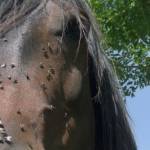Bot Infestations in Horses

The flying insects known as bots are often a nuisance to horses. Late summer and early autumn are prime egg-laying times, and females often continue laying eggs until the first hard frost.
Female bot flies lay eggs or nits on the body hair of horses and other equines. The specific bot species determines where those eggs will be laid. The common bot eggs are usually found on the forelimbs, typically on the inside of the legs, while throat bot eggs are laid on the long hairs of the jaw. Nose bot eggs are laid on the upper and lower lips. During their lifetime, female bots will lay hundreds to thousands of eggs.
Eggs or hatched larvae enter the gastrointestinal tract of the horse through the mouth as horses scratch or lick, or through the migration of nose bot larvae. The larvae stay in the mouth for about three weeks and then travel to the stomach, where they use specialized hooks to attach themselves to the stomach lining. Bots typically spend about seven months in the stomach before they pass out of the digestive tract with the feces. The mature larvae burrow into the soil beneath the manure pile and pupate. Depending on the season, an adult fly emerges in two to eight weeks.
Even severe bot larvae infections rarely cause problems for horses. Occasionally, bots can severely damage the lining of the stomach, lead to gastric rupture, or cause gastrointestinal problems such as colic.
Deworming products that control bots include ivermectin and moxidectin, though careful review of the label as well as consultation with a veterinarian will ensure that proper prevention is implemented.








